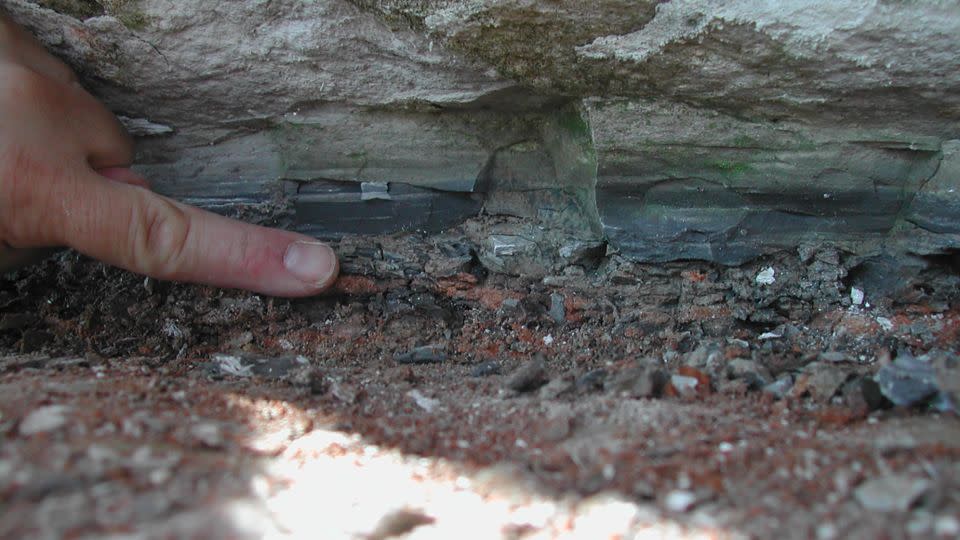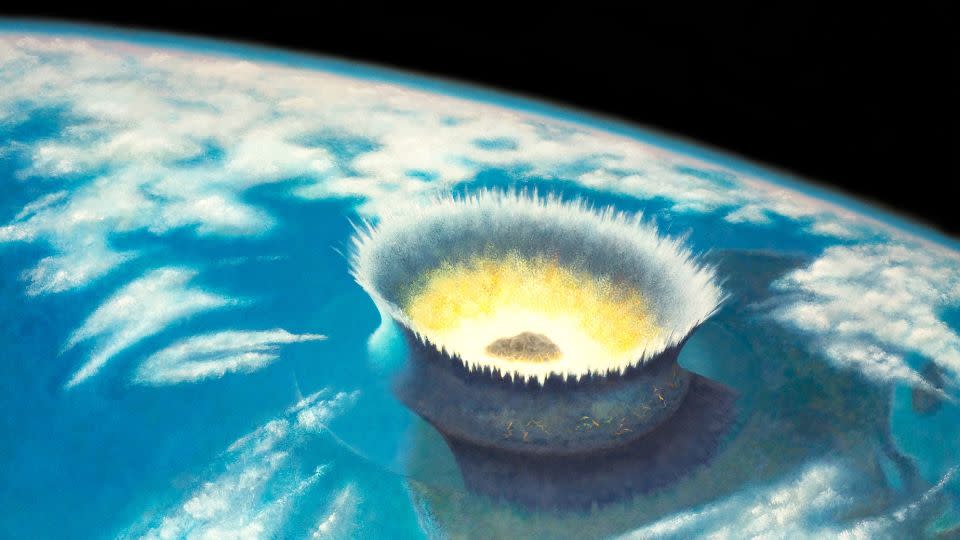Dinosaur-killing asteroid was likely a giant mudball, study says
Sign up for CNN’s Wonder Theory science newsletter. Explore the universe with news on fascinating discoveries, scientific advancements and more.
Sixty-six million years ago, the story of life on Earth took a dramatic turn when an asteroid collided with what’s now the Yucatán Peninsula in Chicxulub, Mexico. The aftereffects of the collision resulted in the extinction of an estimated 75% of animal species, including most dinosaurs except for birds. But practically nothing of the asteroid itself remains.
In a new study published Thursday in the journal Science, researchers pieced together the chemical identity of the asteroid that fueled the planet’s fifth mass extinction event. The dino killer was a rare clay-rich mudball containing materials from the dawn of the solar system, the findings suggest.
While the Chicxulub asteroid landed tens of millions of years ago, learning about this ancient space rock is important because it’s “part of a bigger picture of understanding the dynamic nature of our Solar System,” said study coauthor Dr. Steven Goderis, a research professor of chemistry at Vrije Universiteit Brussel.
Laying out a theory for nonavian dinosaur extinction
Scientists hypothesized in 1980 that a collision with a giant space rock led to the death of the dinosaurs. Back then, the researchers didn’t find the asteroid itself; instead, they found a thin layer of the metal iridium in rocks around the world from 66 million years ago. Iridium is rare within the Earth’s crust but abundant in some asteroids and meteorites.
Some members of the wider scientific community were skeptical of the hypothesis. However, in 1991, scientists found that the Chicxulub crater was the right age to have been formed by a massive asteroid strike coinciding with the demise of the dinosaurs. Over the years, researchers have gathered more and more evidence that the asteroid strike was indeed the impetus for the cataclysmic extinction event.
The asteroid was huge — likely between 6 and 9 miles (9.7 and 14.5 kilometers) in diameter. But its colossal size is why it largely disappeared. The rock, roughly the size of Mount Everest, hurtled toward Earth, traveling 15.5 miles per second (25 kilometers per second), according to NASA.

“Basically, all this kinetic energy is converted into heat,” Goderis said. “When the thing hits the target, it will more than explode; it will be vaporized.” The impact created a cloud of dust composed of the asteroid itself and the rock it landed on. The dust spread worldwide, blotting out sunlight and lowering temperatures for years, resulting in mass extinction.
As for the asteroid, “there’s nothing left except for this chemical trace that is deposited all around the globe,” Goderis said. “This forms this tiny clay layer you can recognize everywhere in the world, and it’s basically the same instant in time, 66 million years ago.”
Dinosaur-killer asteroid chemical makeup revealed
Asteroids (and the smaller meteoroids that break off of them) come in three major varieties, each with their own chemical and mineral makeup: metallic, stony and chondritic. In the new study, Goderis and his colleagues, including the study’s lead author, Dr. Mario Fischer-Gödde of the University of Cologne in Germany, examined the chemical composition of the thin clay layer to unlock the asteroid’s secrets.
The researchers sampled 66 million-year-old rocks from Denmark, Italy and Spain and isolated the parts containing the metal ruthenium. (Like iridium, ruthenium is more abundant in space rocks than in Earth’s crust.) The team also analyzed ruthenium from other asteroid impact sites and meteorites. The chemical makeup of the ruthenium from 66 million years ago matched the chemical makeup of the ruthenium present in a certain kind of chondritic meteorite, the scientists found.
“We noticed that there’s a perfect overlap with carbonaceous chondrite signatures,” Goderis said. Therefore, the asteroid that killed the dinosaurs was probably a carbonaceous chondrite, an ancient space rock that often contains water, clay and organic (carbon-bearing) compounds.
While carbonaceous chondrites make up the majority of rocks in space, only about 5% of the meteorites that fall to Earth belong to this category. “There is quite some diversity in carbonaceous chondrites, and some of them can smell,” Goderis said. But in the inferno, when the Chicxulub impactor landed, Goderis said, “you probably wouldn’t have had the time for a good sniff.”
What the findings mean for the future
Impacts of the scale of Chicxulub happen only every 100 million to 500 million years. But because there is still an outside chance of Earth crossing paths with another asteroid or giant meteorite, Goderis said that it’s good to know “the physical and chemical properties of these objects, to think about how to protect ourselves” from a collision with a large space rock.

Goderis cited the 2022 DART mission, or the Double Asteroid Redirection Test, in which NASA sent a spacecraft to intentionally knock an asteroid off its course. Knowing how different types of asteroids interact with the physical forces around them would be critical for an effective planetary defense operation.
“The carbonaceous chondrite will react completely differently from an ordinary chondrite — it’s much more porous, it’s much more light and it will absorb much more of an impact if you send an object towards it. So, we need to learn about this to have a corresponding response,” Goderis said.
Dr. Ed Young, a professor of cosmochemistry at the University of California, Los Angeles, who was not involved with the study, agreed with the findings.
He said the discovery “adds richness to our understanding of what happened” when the dinosaurs went extinct. Young noted that the researchers’ assessment that the asteroid was a carbonaceous chondrite “is a robust conclusion.”
Kate Golembiewski is a freelance science writer based in Chicago who geeks out about zoology, thermodynamics and death.
For more CNN news and newsletters create an account at CNN.com
